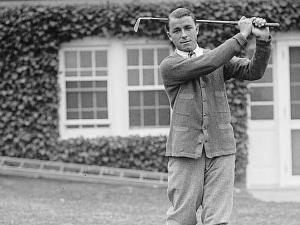Did he secretly use an illegal club?
There is one thing I have learned over the past 25 years playing golf – being over six feet tall and weighing 210 pounds does not mean you will hit your drive consistently over 250 yards down the fairway.
Work on your stance, grip and swing, then forget your height and weight. This is correct technique that will give you a consistent drive of 275-300 yards and a chance to be in the World Golf Hall of Fame. My garage was full of trick clubs from the late 1990s that promised longer, straighter drives and a low golf score. Bottom line, take a lesson and spend your money wisely, no matter your size or gender.
Case in point: A future hall of fame golfer named Eugenio Saraceni, who stood only 5-feet-5 1/2-inches tall as a full-grown adult, took on all comers and would often out-drive other future hall of famers.
On Feb. 7, 1902, in Harrison, N.Y., Eugenio was born to poor Italian immigrant parents. Like many future hall of famers, he had to drop out of grade school and go to work to help support the family. His new job caddying at the local golf course would change his life forever.
Eugenio Saraceni, who later changed his name to Gene Sarazen, loved the game of golf at an early age. At age 9, his parents gave him a used golf club for his birthday, and Gene was determined to teach himself the game when he wasn’t working as a caddy.
At age 13, he shot his first round under 70, but his young career was put on hold when his father made him get a higher-paying job in a carpenter shop. After two years of bad health from working indoors, a doctor recommended that he get a job outdoors.
This turn of fortune landed him an assistant pro job back at the local golf course and at age 18, he turned into a full-time professional golfer. Two years later, at the tender age of 20, he won both the U.S. Open and the PGA Championship.
The next year, he again won the PGA Championship and in 1927, he played on the first Ryder Cup Team, which defeated the Europeans 9 ½ to 2 ½. In 1931, he reinvented the sand wedge to the standard we use today, and in 1932 used it to win the U.S. Open and the British Open (*19th Hole Trivia). When he won his third U.S. Open the next year, pro golfers as well as amateurs began to use his newly designed club.
Arguably the best shot of his career came in his first appearance in the 1935 Masters Championship. Behind by three shots on the par five 15th fairway, he hit a four wood for his second shot, which traveled 235 yards and rolled into the hole for a double eagle. With that shot, he tied the tournament leader, Craig Wood, and beat him in a 36-hole playoff 144-149, to win his only Masters Championship.
Nicknamed “The Squire,” he became a golfing legend around the world and played competitively until 1973. (Sidebar- At age 71, Sarazen played in the 1973 British Open and hit a hole-in-one on the famed “postage stamp hole” at the Royal Troon Golf Course).
Sarazen finished his career with 39 PGA tour wins, including seven major tournaments. He was elected to the World Golf Hall of Fame in 1974 and died in 1999 at age 97, in Naples, Fla.
19th Hole Trivia:
• In 1991, Ian Woosnam won the Masters to become the shortest winner ever; Sarazen was 5-feet-5 1/2-inches, while Woosnam was 5-feet-4 1/2-inches.
• When Sarazen won the 1935 Masters Tournament, he became the first golfer to win the professional Grand Slam – The Masters, The U.S. Open, The British Open and The PGA Championship.
• In 1966, he was awarded the PGA’s first Lifetime Achievement Award.
• In 2000, Golf Digest ranked him the 11th greatest golfer of all time.
• Bobby Jones and Walter Hagen both witnessed Sarazen’s double eagle at the 1935 Masters Tournament.
• Sarazen claimed to have invented the modern sand wedge and debuted the club (while keeping it secret during preliminary practice rounds) at The Open Championship at Prince’s Golf Club in 1932, which he won. Was this club legal?





















































